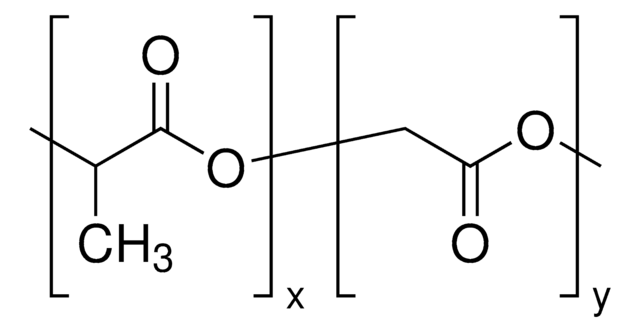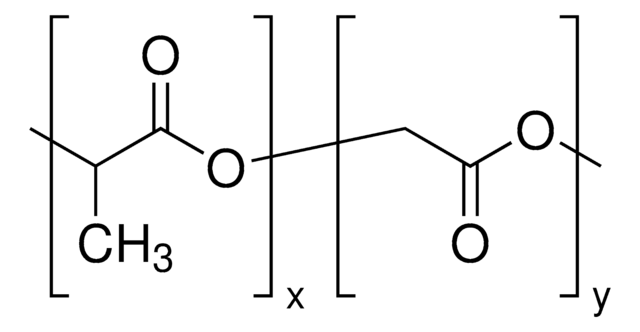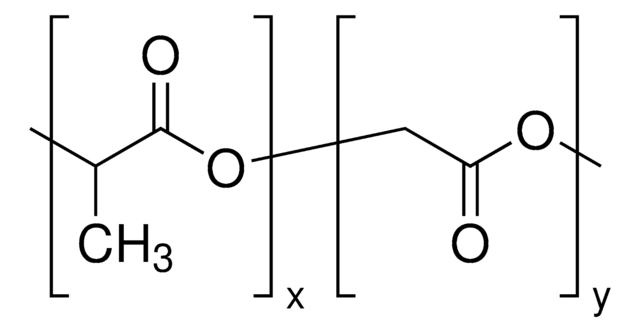Product 430471 has a dodecyl (12 carbon) ester on one end of the polymer chain and a hydroxyl end group on the other.
430471
Poly(D,L-lactide-co-glycolide)
ester terminated, Mw 50,000-75,000
Synonym(s):
Lactel® B6006-1, PLGA
Select a Size
About This Item
Recommended Products
Quality Level
form
amorphous
feed ratio
lactide:glycolide 85:15
mol wt
Mw 50,000-75,000
degradation timeframe
<6 months
viscosity
0.55-0.75 dL/g, 0.1 % (w/v) in chloroform(25 °C)
transition temp
Tg 45-50 °C
solubility
ethyl acetate, chloroform, acetone and THF: soluble
storage temp.
2-8°C
SMILES string
OCC(O)=O.CC(O)C(O)=O
InChI
1S/C3H6O3.C2H4O3/c1-2(4)3(5)6;3-1-2(4)5/h2,4H,1H3,(H,5,6);3H,1H2,(H,4,5)
InChI key
XBBVURRQGJPTHH-UHFFFAOYSA-N
Looking for similar products? Visit Product Comparison Guide
General description
Application
Features and Benefits
Physical form
Legal Information
Storage Class Code
11 - Combustible Solids
WGK
WGK 3
Flash Point(F)
Not applicable
Flash Point(C)
Not applicable
Personal Protective Equipment
Choose from one of the most recent versions:
Already Own This Product?
Find documentation for the products that you have recently purchased in the Document Library.
Customers Also Viewed
Articles
Interest in utilizing biodegradable polymers for biomedical applications has grown since the 1960s.
Synthetic aliphatic polyesters dominate resorbable biomaterials in clinical use.
AliAliphatic polyesters, including polylactide and polyglycolide, are biodegradable polymers widely used in medical applications.
Immunosuppressive tumor-associated myeloid cells (TAMC) are responsible for glioblastoma (GBM) resistance to immunotherapies and existing standard of care treatments. This mini-review highlights recent progress in implementing nanotechnology in advancing TAMC-targeted therapies for GBM.
-
What are the end groups of Product No. 430471 (Poly(DL-lactide-co-glycolide)?
1 answer-
Helpful?
-
-
What is the tensile strength of Product No. 403471 Poly(DL-lactide-co-glycolide)?
1 answer-
Product 430471 has a tensile strength of 6000 - 8000 psi, with an elongation of 3-10%.
Helpful?
-
-
What is the Department of Transportation shipping information for this product?
1 answer-
Transportation information can be found in Section 14 of the product's (M)SDS.To access the shipping information for this material, use the link on the product detail page for the product.
Helpful?
-
-
What is the density of Product No. 430471 Poly(DL-lactide-co-glycolide)?
1 answer-
According to the manufacturer, product 430471 has a theoretical density of 1.27g/mL.
Helpful?
-
-
Is Product No. 403471 a resorbable polymer?
1 answer-
Yes, Product No. 430471 has a resorption time of 5-6 months.
Helpful?
-
-
How is this Product No. 430471 synthesized (Poly(DL-lactide-co-glycolide)?
1 answer-
To synthesize product 430471, 1-dodecanol is used as an initiator and stannous octoate is used as a catalyst to start the ring opening polymerization of D,L-lactide and glycolide monomers.
Helpful?
-
Active Filters
Our team of scientists has experience in all areas of research including Life Science, Material Science, Chemical Synthesis, Chromatography, Analytical and many others.
Contact Technical Service




